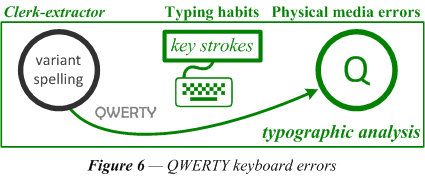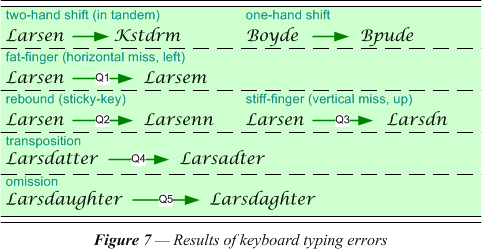
1.1 Mistyping. Typographical errors occur when a clerk-extractor unintentionally creates a variant spelling by mistakingly typing a spelling using a keyboard inaccurately.

The QWERTY arrangement of the keys makes certain letters more likely to be struck in error. If the extractor is a touch-typist, the conventional hand position is fixed, so that the hand may shift by mistake. The result of such an error is that all keys struck by that hand are shifted together. If both hands are shifted in tandem, the error is so severe that all the characters typed correspond to different keys making the result decipherable only with extreme difficulty. Such garbled representations are not normally recognizable to the interpreter.
If the extractor is a hunt-and-peck typist, the errors are usually much easier to recognize because only one or some few letters in a name are wrongly represented. The single finger doing the typing mistakingly hits an adjecent key, which may be on the same horizontal row, or just up or down from it.
Whatever the style of the typist, the sequence of the keys struck may be the source of the error. It may happen that the same key may be hit multiple times or omitted completely. Similar to this is the error where two letters of the name are interchanged dyslexically. These kinds of error are strictly not QWERTY since any arrangement of the keyboard could not change their occurrence or avoid their manifestation.

An extreme example of a two-hand shift is given in figure 7 along with an assortment of several other kinds actually discovered during a study of Danish patronymic suffixes. These endings are usually so pervasive and distinctive that typing errors in them are much more readily detectable than in shorter non-patronymic surname forms.
